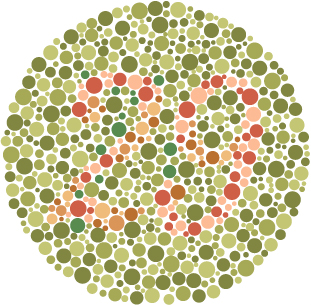Last week I carried out a first ever eye examination on former Scotland rugby captain Mike Blair who was recounting stories of problems he has experienced with colour deficiency prompting me to write this blog. In one particular match in Aberdeen he stepped out on to a snow-covered pitch an hour before Scotland were set to kick off, only to find the lines had been marked out in red to make them standout from the snow. However for Mike, this meant the lines were now indistinguishable. From the usual crisp, clear lines he was used to seeing, he could now only see the grass and snow. The result was the groundsmen had to busily change them before kick-off and spectators arrived to see a rare sight – a pitch with pink markings.

This is a classic example of red/green colour deficiency which affects around 5% of men and very few women. The degree to which people are affected varies. Usually individuals can distinguish between very bright reds and greens. It is the less vibrant versions of the colours that cause the problems, and distinguishing between shades of red or green can be nigh on impossible. The condition is often referred to as ‘colour blindness’ which is an inaccurate term as those with the condition can still see colour not black and white.
The reason that more men suffer this form of colour deficiency relates to the fact that it is carried through the 23rd chromosome, commonly referred to as the sex chromosome. So both a mother and father would have to be carriers of the faulty gene for it to be passed to a daughter whereas just the mother has to be a carrier for her to pass it to her son.
Whilst it rarely causes individuals major problems, it does rule out certain professions-pilots and electricians are two that spring to mind. It is worth parents noting that the condition may go unnoticed as it is may not be routinely tested for. It is advisable to get children (really only boys) tested for colour deficiency before they start school to ensure it is spotted early. Many learning materials are not tailored to the needs of those with colour deficiency so children may struggle unnecessarily if undetected.
PS. If you can’t see the 29 on the coloured dot diagram above (called the ‘Ishihara test’ by the way), you should come and get your eyes examined!












